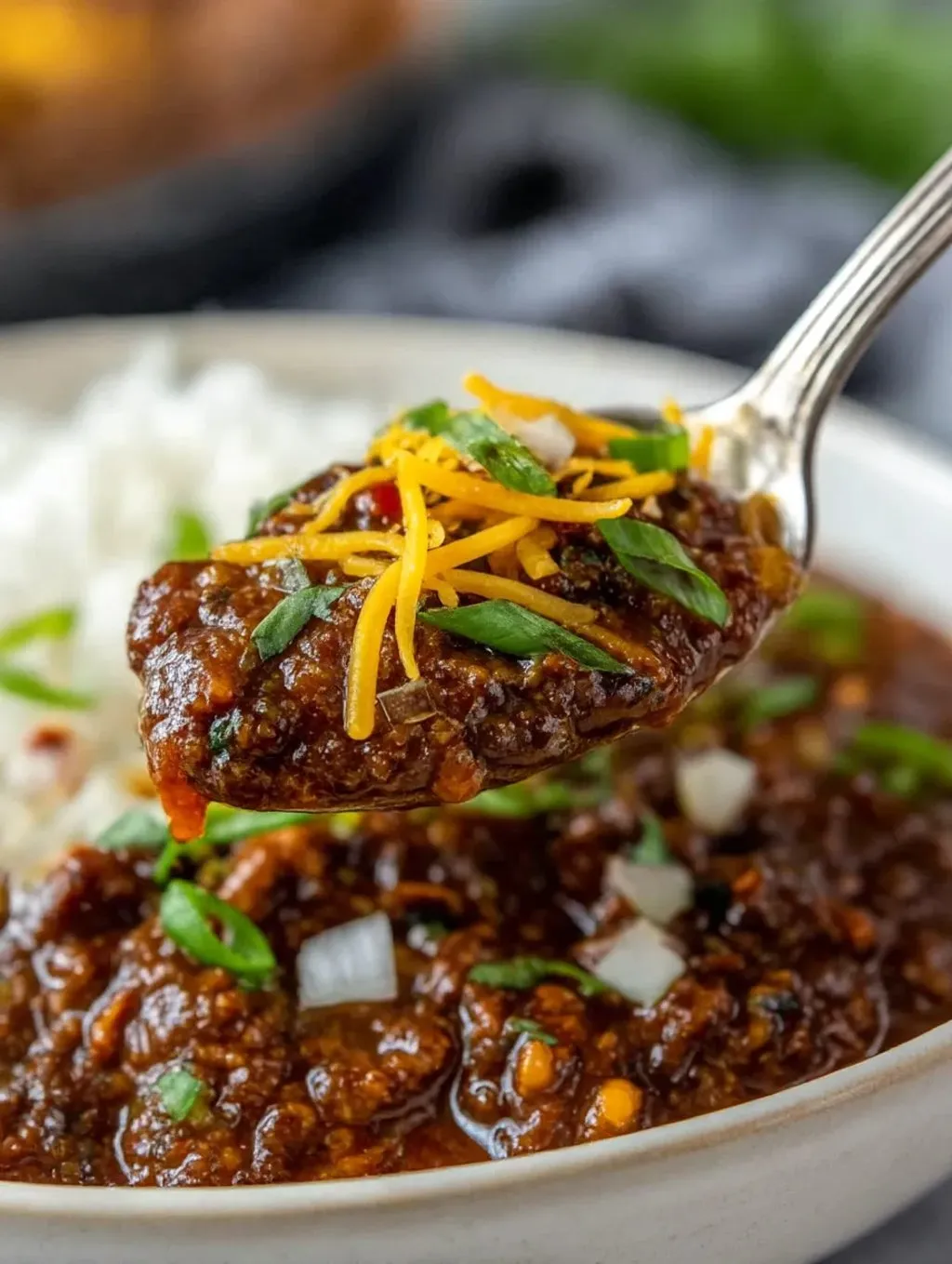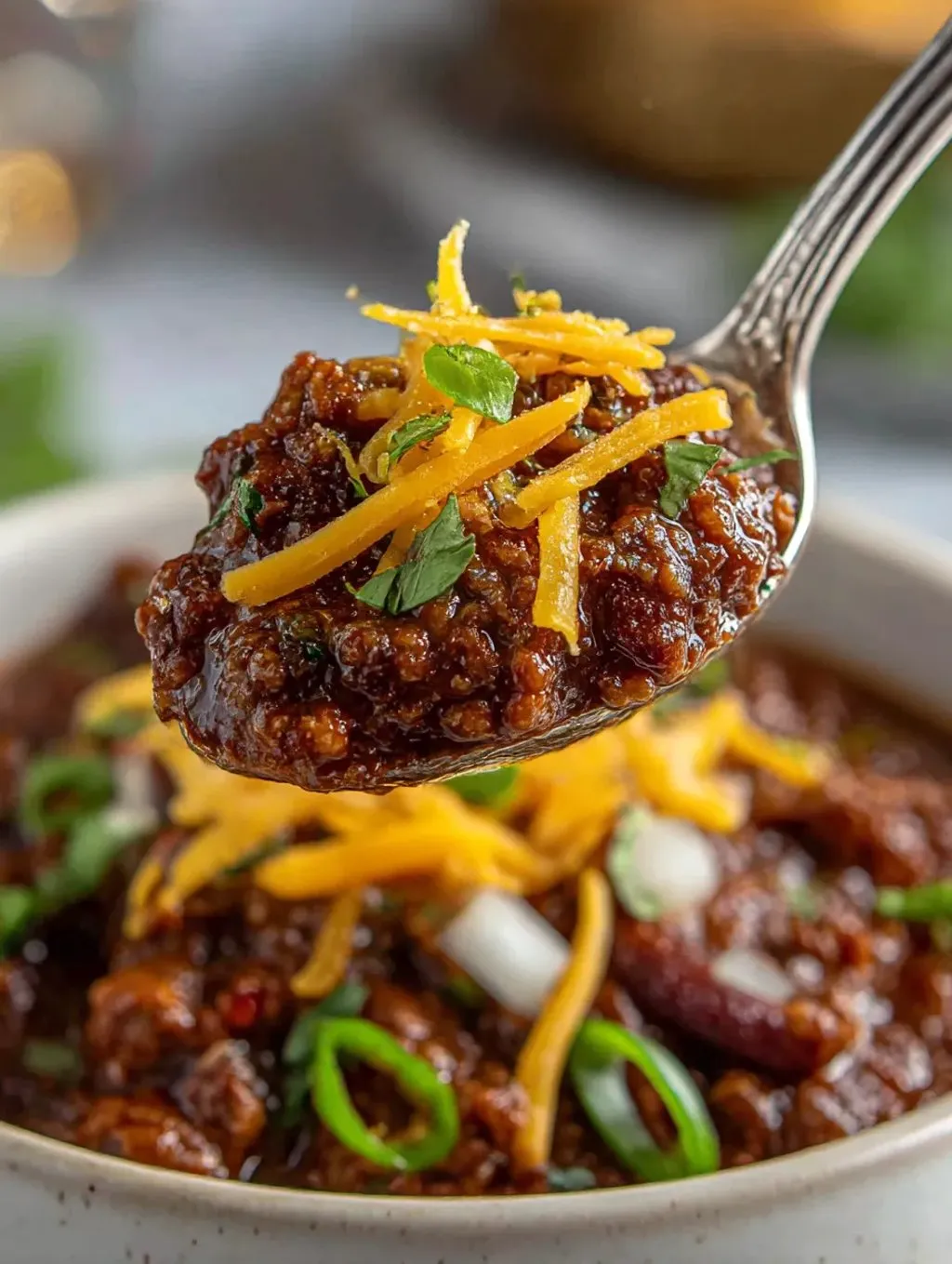 Pin
Pin
This Korean Chile Con Carne is a spicy and savory twist on a Texas classic, simmered low and slow for maximum depth. Featuring a blend of Korean and Mexican chiles, robust beef, and savory tomatoes, this recipe never fails to impress with its warmth and bold flavors.
When I first tried blending gochujang with classic chili, my family devoured the whole pot in one night. Since then, this recipe is my go-to when I want something comforting but never boring.
Ingredients
- Beef chuck roast cut into cubes: This cut stays melt-in-your-mouth tender after slow braising and brings serious beefy flavor. Look for well-marbled pieces for best results.
- Beef tallow or neutral oil: Helps develop a deep brown sear and add richness. If using oil, pick one with a high smoke point.
- Kosher salt and fresh ground black pepper: Season the beef generously before searing to create a flavorful crust.
- Red onion and fresh jalapenos: These fresh aromatics lay the foundation for the chili’s punch and subtle sweetness.
- Garlic cloves: Adding depth and piquancy when sautéed gently. Pick firm, unblemished cloves.
- Chipotle pepper in adobo with adobo sauce: Smoky and spicy, this brings a subtle lingering heat and complexity.
- Dark brown sugar: Balances the heat and enhances caramelization for a well-rounded profile.
- Ground cumin and ground coriander: Toasty spices for earthy backbone. Use freshly ground for the brightest flavor.
- Smoked salt: Layers in woodsy aroma and intensifies the meaty depth.
- Fire-roasted tomatoes: Canned roasted tomatoes lend natural sweetness and a hint of char. Check for a thick, chunky variety.
- Negro Modelo or other dark beer: Beer brings a malty backbone that matches well with the spicy chiles. Choose a stout or porter if you like.
- Gochujang: The backbone of Korean heat and umami. Choose one labeled medium heat unless you prefer extra spice.
- Beef broth: Use a low-sodium, high-quality broth for the right balance of saltiness and beefiness.
- Gochugaru: Korean chile flakes supply a final wave of peppery heat and a signature brick-red color. Look for flakes that are bright and slightly fruity.
Step-by-Step Instructions
- Sear the Beef:
- Pat the beef dry and season generously with kosher salt and black pepper. In a Dutch oven over high heat, heat the beef tallow until shimmering. Working in batches, sear all sides of the beef cubes until deeply browned and crispy. Transfer each batch to a paper towel lined plate. This step adds the foundation for a meaty chili.
- Build the Aromatics:
- Lower the heat in the pot to medium. Add a bit more fat if needed, then toss in the finely diced red onion and jalapenos. Stir constantly to avoid sticking, cooking just until the vegetables are softened and begin to pick up dark edges about 2 minutes. Add in the minced garlic, chipotle peppers, adobo sauce, cumin, coriander, smoked salt, and dark brown sugar. Mix well and cook for another minute to open up the spice aromas.
- Combine Sauces and Liquids:
- In a separate bowl, whisk the gochujang into the beef broth until smooth. Pour this mixture into the pot, then add the dark beer and fire-roasted tomatoes including all juices. Use a wooden spoon to scrape any browned bits from the pot’s bottom. Return all the seared beef to the pot to soak up the flavors.
- Simmer Low and Slow:
- Turn the heat to a gentle simmer. Place a lid on if you want a thinner chili or leave it off for a thicker consistency. Cook for 2 to 3 hours stirring occasionally until the beef is completely tender and the chili is richly thickened. For extra heat, stir in gochugaru halfway through simmering.
- Finishing Touches:
- Before serving, stir in freshly chopped cilantro or scallions if desired. Taste and adjust seasoning with salt or pepper as needed. Spoon into bowls and top with white onion, cheddar cheese, or your favorite garnishes. Serve hot over rice or with warm bread.
 Pin
Pin
The interplay between gochujang and fire-roasted tomatoes makes this recipe unforgettable. I will never forget when my friend tried it for the first time and demanded the recipe right after the second spoonful.
Storage Tips
Cool the chili completely before transferring to airtight containers. It keeps well refrigerated for four days and freezes for up to three months. I always make extra and freeze single portions for busy weeknights.
Ingredient Substitutions
If you cannot find beef chuck roast, use brisket or boneless short ribs for a similar texture. For a vegetarian version, swap in diced portobello mushrooms and black beans but keep the gochujang for signature depth. Fire-roasted tomatoes bring key flavor but a good quality plain diced tomato works in a pinch.
Serving Suggestions
This chili is fantastic with steamed jasmine or white rice which soaks up every bit of sauce. For added richness, top with shredded sharp cheddar, sliced scallions, or a fried egg. Sometimes I serve it with toasted sesame bread for a fusion touch.
 Pin
Pin
Cultural Context
Blending gochujang into chili unites two comfort food traditions Korean stews and American chili each famous for their capacity to feed a crowd and warm the soul. Adding elements like chipotle and beef highlights the connections between bold flavors across cuisines.
Recipe FAQs
- → What makes this chili spicy?
The heat comes from four types of chiles: fresh jalapeños, chipotle peppers in adobo, gochugaru (Korean chile flakes), and gochujang paste, creating depth and complexity in every spoonful.
- → Can I substitute gochujang?
No, gochujang is a unique fermented ingredient that delivers both heat and umami. Substituting it will alter the dish’s character and depth of flavor.
- → How do I get the beef tender?
Browning the beef first and then simmering it gently for several hours breaks down the meat’s fibers, resulting in a melt-in-your-mouth texture.
- → What toppings pair well?
Garnish with white rice, shredded cheddar, scallions, diced onions, sesame seeds, or even a soft egg for added richness and texture.
- → Can it be made less spicy?
To reduce the heat, use less gochugaru and jalapeños, or omit the extra chile flakes, while keeping the savory depth intact.
- → Is it necessary to use dark beer?
Dark beer adds a unique richness, but you can substitute with a lighter beer or additional broth if desired for a different flavor profile.
